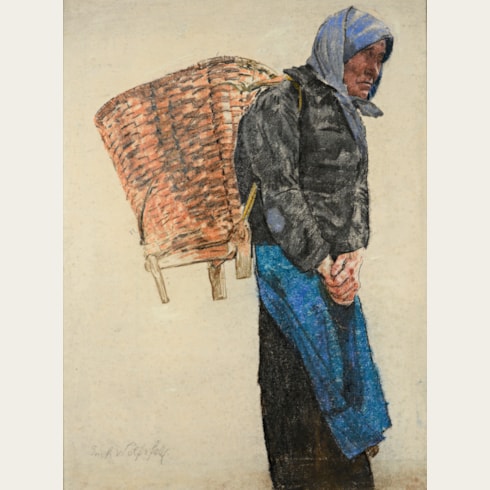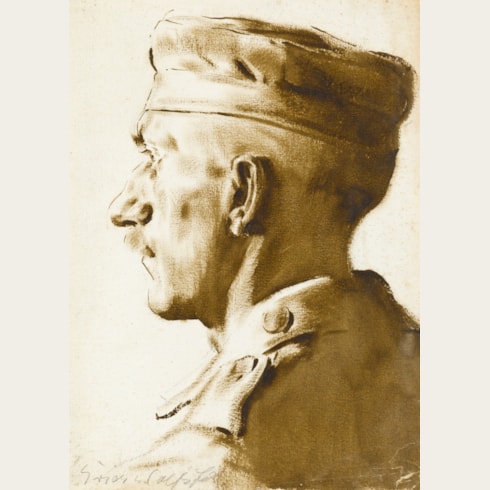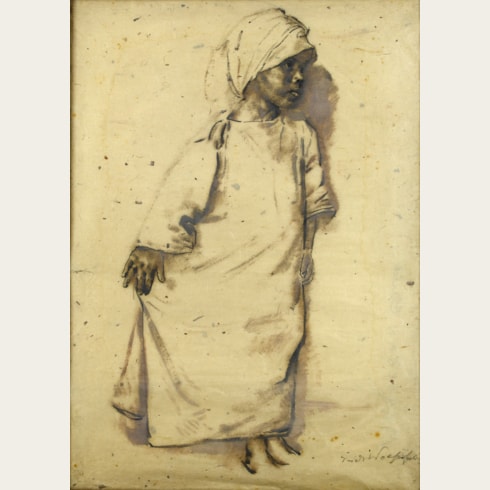Erich WOLFSFELD
(Krojanke 1884 - London 1956)
Study of a Moroccan Baby
Sold
Oil on paper.
A sketch of the head of a baby in pencil on the verso.
Inscribed Geshenck an / Fol. Irna Schönfeld zu / ihrem Gebürtstag am / 15.12.1943 / 15 Lauderdale Mansions / London W8 / Studie eines marokkanischen Babies / von Professor Erich Wolfsfeld, / Lehrer an der Berliner Kunst- / Akademie bis 1936 on the verso.
Further inscribed Sketch of a Morocco Child on the back of his mother / Given to me by E. Wolfsfeld on my / birthday 1943, Lauderdale Mansion, W.8 London. in blue ink on the backing board, and Professor Erich Wolfsfeld, / of the Academy of Fine Arts, / Berlin. / Germany / up to 1936. ion the backing board.
Also inscribed At the back of this / sketch is a rough drawing / of baby Jill Pomerance / (Parents Ben and Fay Pomerance / of Sheffield) on a label pasted onto the backing board.
392 x 281 mm. (15 3/8 x 11 1/8 in.)
A sketch of the head of a baby in pencil on the verso.
Inscribed Geshenck an / Fol. Irna Schönfeld zu / ihrem Gebürtstag am / 15.12.1943 / 15 Lauderdale Mansions / London W8 / Studie eines marokkanischen Babies / von Professor Erich Wolfsfeld, / Lehrer an der Berliner Kunst- / Akademie bis 1936 on the verso.
Further inscribed Sketch of a Morocco Child on the back of his mother / Given to me by E. Wolfsfeld on my / birthday 1943, Lauderdale Mansion, W.8 London. in blue ink on the backing board, and Professor Erich Wolfsfeld, / of the Academy of Fine Arts, / Berlin. / Germany / up to 1936. ion the backing board.
Also inscribed At the back of this / sketch is a rough drawing / of baby Jill Pomerance / (Parents Ben and Fay Pomerance / of Sheffield) on a label pasted onto the backing board.
392 x 281 mm. (15 3/8 x 11 1/8 in.)
This vigorous oil sketch of a baby, depicted resting on its mother’s back, can be related to a similar figure in a large painting of North African women and children which was on the art market in London in 1990. The same child also appears in an oil sketch of Arab figures that appeared on the art market in England in 2009.
The pencil sketch of the head of a baby on the verso of the sheet is, according to a label pasted onto the backing board, a portrait of Jill Pomerance, the daughter of the painter Fay Pomerance. Mrs. Pomerance befriended Wolfsfeld soon after his arrival in England, and the artist lived at her house in Sheffield both before and after his period of internment on the Isle of Man. Pomerance also organized the first exhibition in England of Wolfsfeld’s work, held at the Graves Art Gallery in Sheffield in 1939. In a brief written account of her friendship with Wolfsfeld, Fay Pomerance recalled that ‘I think his favourite commissions were those of children, for he delighted in them and in painting them. He first painted our daughter Jill when she was a very small infant – three head studies with a fourth thrown off while he was cleaning his brushes, prompting an enquiry of me following the Graves exhibition as to how my triplets were doing!’
The pencil sketch of the head of a baby on the verso of the sheet is, according to a label pasted onto the backing board, a portrait of Jill Pomerance, the daughter of the painter Fay Pomerance. Mrs. Pomerance befriended Wolfsfeld soon after his arrival in England, and the artist lived at her house in Sheffield both before and after his period of internment on the Isle of Man. Pomerance also organized the first exhibition in England of Wolfsfeld’s work, held at the Graves Art Gallery in Sheffield in 1939. In a brief written account of her friendship with Wolfsfeld, Fay Pomerance recalled that ‘I think his favourite commissions were those of children, for he delighted in them and in painting them. He first painted our daughter Jill when she was a very small infant – three head studies with a fourth thrown off while he was cleaning his brushes, prompting an enquiry of me following the Graves exhibition as to how my triplets were doing!’
Born in western Prussia, Erich Wolfsfeld enrolled in 1904 at the Berlin Academy of Arts, studying drawing with Konrad Böse, a follower of Adolph von Menzel, and etching with Hans Meyer. He completed his studies with Jules Lefèbvre at the Académie Julien in Paris in 1906, and between 1908 and 1909 lived and worked in Rome, where he befriended other expatriate German artists such as Otto Greiner and Max Klinger. Wolfsfeld’s early career was largely devoted to printmaking, and in Rome he produced a number of large etchings of nudes and Roman beggars. Beggars were to serve as a common motif in his work throughout his later career, though always imbued with a particular dignity. On his return to Berlin, he won a gold medal for an etching entitled The Archers in 1910.
Wolfsfeld soon began painting in oils, although he seems to have always worked on treated paper, rather than on stretched canvas, as the former could be easily carried in large rolls. In 1918 he took up a post as a professor of drawing at the Akademie in Berlin. Two years later he rose to the position of professor of painting and etching, and in the same year the first monograph devoted to his work was published. In 1924 an exhibition of his etchings was held in Vienna to considerable acclaim, and the following year he exhibited twenty-nine paintings of Turkish or Moroccan subjects in Berlin. He travelled widely in Europe, and was also in particular drawn to North Africa and the Middle East. In 1928 Wolfsfeld made a trip through Egypt and Palestine that had a profound impact on him, and led to the publication of an account of his travels entitled Einedrücke von einer Orientreise. Although he was a popular and highly regarded teacher, Wolfsfeld, as a German Jew, was forced to resign from the Akademie in 1935 as a result of Nazi pressure. Three years later he emigrated to Britain, if somewhat reluctantly, bringing much of his work with him but leaving behind a large painting of Joseph and his Brethren, now in the Magdalenakirche in Berlin.
After a brief period at an internment camp on the Isle of Man, Wolfsfeld settled first in Sheffield and later in London. An exhibition of his work, held at the Graves Art Gallery in Sheffield in 1939, led to a number of portrait commissions, and in 1943 he exhibited his etchings at the Royal Academy. But he seems to have been quite unsettled by his uprooting from Germany, and only a relatively few works may be dated to the war years. After the war he remarried and moved to a large home and studio in Golders Green, where he worked in his habitual outfit of a long white Arab robe. He also began again to travel, visiting favourite sites in Brittany, Morocco and Spain. A large and comprehensive exhibition of his work, numbering 163 paintings, drawings and prints, was held at the Derby Art Gallery in 1953. Three years later, shortly before his death, he was elected an associate member of the Royal Society of Painter-Etchers and Engravers, and in the same year was included in an exhibition of Jewish painters in England, held at the Whitechapel Art Gallery.
Two years after Wolfsfeld’s death in 1956, a memorial exhibition of his work was mounted at the Ben Uri Art Gallery in London, and later exhibitions of his work were held at the Jewish Community House in Berlin in 1962 and at Turner House in Penarth in 1978. Wolfsfeld’s work is today represented in several museums in England, notably the National Portrait Gallery, the Victoria and Albert Museum and the Imperial War Museum in London, as well as the museums of Huddersfield, Dudley and Birmingham and, further afield, in New York, Vienna, Berlin, Paris, Stockholm and Jerusalem.
Provenance
Given by the artist in December 1943 to Erna Schönfeld, London
Thence by descent to a private collection, Walton-on-Thames, until 2008.










